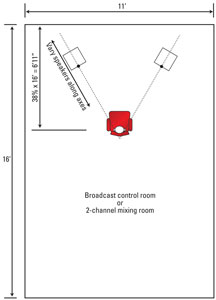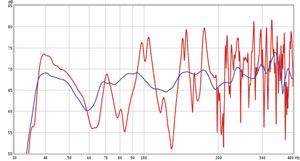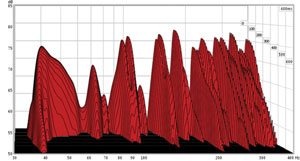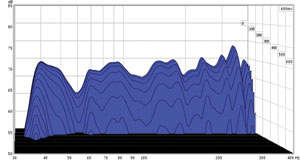Proper loudspeaker placement
Placing the loudspeakers and listening position correctly is the first step toward getting good sound, especially at low frequencies. While positioning alone won’t eliminate the need for bass traps and other acoustic treatment, it’s an easy and free way to reduce low-frequency response errors and improve imaging. The first step is to identify the ideal listening position within the room, and from there you can determine the best speaker placement.

Figure 1. This shows idealized placements for the loudspeakers and prime listening seat in a room used mainly for stereo playback.
The method used here is based on the 38 Percent Rule, a theory popularized by acoustician Wes Lachot. Lachot has shown that the theoretical best listening position is 38 percent into the length of the room, when measured from the front wall. This offers the best compromise of bass peaks versus nulls for any given room size. (See Figure 1.)
Understand that 38 percent is only the theoretical best location. It’s a good starting point, but in practice it may not be best due to other factors — wall properties, speaker type and location, or perhaps a mixing console that’s too large to fit that way.
Once you’ve decided where to put your seat, the next step is placing the loudspeakers. The speakers and listening position should define an equilateral triangle, with the distance between the left and right speakers the same as the distance from your head to each speaker. Tweeters should also be at ear level and pointed toward you for the flattest response, because most speakers have a skewed response with less high-frequency output off-axis.
Symmetry
Left-right symmetry in a room is critical for good stereo imaging. If your setup is placed more to one side of the room, instruments and voices coming equally from both speakers will not sound centered as they should. When perfect symmetry is not possible throughout a room, at least aim for symmetry in the front. The most important area is along the side walls between your head and the speakers.
In rectangular rooms, the low bass response is most lacking at the halfway points — halfway between the front and rear walls, halfway between the left and right side walls, and halfway between the floor and ceiling. Therefore, the bass response is worst if you sit in the exact center of the room, at a height that puts your ears halfway between the floor and ceiling. You shouldn’t put speakers along any of those centerlines for the same reason; when a loudspeaker is in a room’s null spot, its output is reduced considerably at low frequencies whose wavelengths are related to that dimension.
The best way to know if small positional changes help or hurt is with room measuring software, such as the freeware Room EQ Wizard program. This lets you experiment with different speaker distances by sliding both speakers along their axes as shown, while measuring the response at different proposed listening spots. Otherwise, simply put the speakers at a distance that’s convenient and sensible for the size of your room while keeping an equilateral triangle. Ergonomics matter too!
Low frequencies

Figure 2. The low-frequency responses shown are typical for most small rooms, before (red trace) and after (blue trace) adding bass traps.
Bass frequencies are the most difficult to tame in a small room because the wavelengths are long, which requires thick absorbers called bass traps. The before/after frequency response was measured in the same room as Figure 1 and shows the room’s low-frequency response before and after adding bass traps. (See Figure 2.) You can see three severe nulls around 64Hz, 84Hz and 140Hz in the red before trace, as well as additional nulls at higher bass frequencies.
Most rooms have many such nulls in the range below 300Hz or 400Hz, but some people fear that adding bass traps will reduce the amount of bass even further. In truth, bass traps reduce peaks and also raise nulls, so they make the response flatter, rather than add or remove bass. In many rooms, the main problem is deep nulls caused by reflections from the wall behind you combining out of phase with the direct sound from the loudspeakers. Therefore, adding bass traps increases the perceived level of bass. But in some rooms, especially those that are square- or cube-shaped, peaks can dominate the response. In that case, adding bass traps reduces the peaks, again making the response closer to flat. Whether peaks or nulls are the larger problem also depends on where in the room you listen.


Figures 3 and 4: These graphs are derived from the same measurement data as Figure 2, but they show each peak’s decay time, as well as amplitude. The red graph shows the room when untreated, and the blue graph is after adding bass traps.
Because deep nulls cause you to hear less bass than is really present, you’ll tend to add too much bass to compensate. As you can see, the finest loudspeakers in the world are of little value if your room skews everything you hear this badly. When bass traps are added to a room, the low-frequency response also changes less around the room. The most effective place for bass traps is in corners where bass waves tend to gather, though other locations are also viable. Note that rectangle rooms have 12 corners: four where each wall meets another wall, four where each wall meets the ceiling and four more where each wall meets the floor. After treating as many corners as is practical, the front and rear walls are good candidates for even more bass traps. When bass traps are added, the response not only becomes flatter, but also tighter and clearer because the decay times are reduced. (See Figures 3 and 4.)
It’s impossible to make any small room perfectly flat, so the more bass traps you add, the closer you’ll get. It’s that simple. The only trade-off is how good you want versus how much effort and expense you’ll endure. The response and ringing in these graphs is about as good as can be expected in a small room, short of lining every single inch of room surface with extremely thick absorption.
Finally, it’s worth noting that our ears perceive low frequencies as being omnidirectional. With content below about 100Hz, it’s difficult, if not impossible, to tell where the sound is coming from. Some people think that years of acoustical research are wrong, and people can perceive bass direction at very low frequencies. But I’m convinced the real issue is buzzing and rattling from a woofer or subwoofer, or port noise from a reflex enclosure, or maybe vibration from a nearby window. If you can hear where a subwoofer is placed, and the crossover is 100Hz or lower, then something else is going on.
—Ethan Winer owns RealTraps, an acoustic treatment company in New Milford, CT. This article is excerpted in part from Winer’s new book, The Audio Expert, from Focal Press. More information is available at www.ethanwiner.com/book.htm.
Get the TV Tech Newsletter
The professional video industry's #1 source for news, trends and product and tech information. Sign up below.
